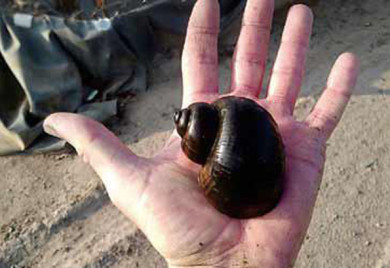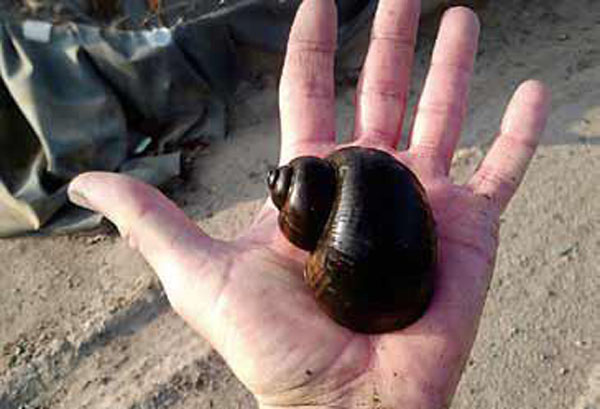Algae Eaters: Apple Snail

Algae Eaters: Apple Snail
Apple snails are great algae eaters but be aware that they will start to eat your aquatic plants if they run out of algae to eat. It is recommended to limit the number of snails you choose to have call your pond their home. As the name implies this snail can get very large. The size of an apple is not uncommon.
Apple snails can live together with mos tpond fish without problem. Also many fish will try to nip at the tentacles of the apple snails, but that should not be a problem, as the apple snails will adapt quickly by keeping their tentacles under their shell. They do have gills besides their lung; they will drown if left without air.
Water quality
Apple snails are not demanding on water quality: they will survive harsh conditions better than most fish. In general, the same rules apply as one would use fro fish to keep the water quality within acceptable limits (filtration, regular water changes etc.). However, as snails need calcium to construct their shell, they prefer hard (calcium rich) water. To protect the shell, the pH of the water should be kept at 7 (neutral water) or higher (alkaline). It’s important to pay attention to this. If the water is too soft, one can increase the calcium concentration by adding powdered marble or lime stone. When the calcium concentration of the water is too low, the shell deteriorates and holes appear. This is not typically a problem. They can live anywhere healthy fish can live.
Apple snail are algae eaters
Apple snails are very easy when it comes to food. In a pond environment they are impressive string algae eaters and they eat almost anything they can tear pieces off and put in their mouth. Vegetables like cucumber, spinach, carrots and lettuce, fish food, dead fishes, other snails and their eggs, algae, brine shrimps, they eat it all. As mentioned before, Pomacea diffusa does only eat very soft and dead vegetation and can better be fed with fish food pellets or with cooked vegetables or canned spinach. Be careful not to foul the water with these types of food.
The amount of food that is given should be adapted to their needs. In general this means one should give no more than they can eat before the food starts rotting in the water. A fear for overfeeding is unnecessary, but it might be a good idea to restrict the amount in smaller tanks to avoid excessive waste production.
Temperature
As apple snails are tropical animals (except some genera like Felipponea and Asolene, which are sub-tropal snails), the temperature of the water should stay within the 65° -85° F ranges. The temperature does not only influence the level of activity, but it an important factor that determines the life cycle speed. With higher temperatures, the life cycle (birth to dead) is reduced from 4 years (at low temperatures) to less than a year, while the reproduction rate increases with the temperature.
Breeding
Successful breeding apple snails depends on many factors.
First of all, a male and a female snail are needed. Most snasil are asexual but apple snails are not. How do you know if you have both? Unfortunately it’s not easy to see the difference without exercise. To play safe, it’s best to keep several apple snails together to enhance the chance of having both.
Secondly, the snails should start mating and producing eggs. High temperatures and plenty of food should trigger them to do so. Note that this can take a while and some patient is needed. Seasonal conditions could influence their reproduction activity.
Once the eggs are ready, the female leaves the water at night in search for a good place to deposit the eggs.
Eggs
The eggs itself are laid one by one and attached to each other in a solid clutch. They are soft and have a milky color when laid, but harden within hours. Their definitive color pinkish to bright orange appears after 1 to 2 days.
The eggs should stay moist, but not wet and never be covered with water, as this will drown the baby snails.
Each clutch can have anywhere from 1 to 600 baby snails. Now, if you decide that you want to take on baby snails, hatching depends on species and environment. Most snails all hatch between 2 and 4 weeks. The higher the water temp, the sooner they hatch.
If you have any questions about other Pond Fish, Koi For Sale, Gold Fish For Sale, Algae Eaters or have questions about getting the right pond fish for your pond, please visit our full service Pond Supply store or call Sunland Water Gardens @ 818-353-5131

Apple snail, pond snail, giant pond snail, algae eater, algae control
Pond Fish Category: Pond Fish / Algae Eaters
Source: Sunland Water Gardens
Author: Jacklyn Rodman
Also See: Pond Fish, Algae Eaters
If you have any questions about other Pond Fish, Koi For Sale, Gold Fish For Sale, Algae Eaters or have questions about getting the right pond fish for your pond, please visit our full service Pond Supply store or call Sunland Water Gardens @ 818-353-5131
Areas we serve and more:
Pond Fish For Ponds – Algae Eaters For Ponds
-
Agoura Hills
-
Altadena
-
Arcadia
-
Bel-Air
-
Bellflower
-
Beverly hills
-
Calabasas
-
Encino
-
Glendale
-
Hollywood
-
Hollywood Hills
-
La canada
-
La Crescenta
-
La Cresenta
-
Lancaster
-
Los Angeles
-
Malibu
-
Manhattan Beach
-
Montrose
-
North Hollywood
-
Paramount
-
Pasadena
-
Porter Ranch
-
San Fernando
-
San Marino
-
Santa Clarita
-
Santa Monica
-
Sherman Oaks
-
Simi Valley
-
South Pasadena
-
Studio City
-
Sun Valley
-
Sunland
-
Sylmar
-
Torrace
-
Ventura
-
West Hills
-
West Hollywood
-
Westlake village
-
Woodland Hills
Sunland Water Gardens – Your Pond Supplier since 1965.
A leader in Pond Fish for Ponds – Algae Eaters For Ponds!
Contact the pond fish experts today at 818-353-5131.
Filed under:

